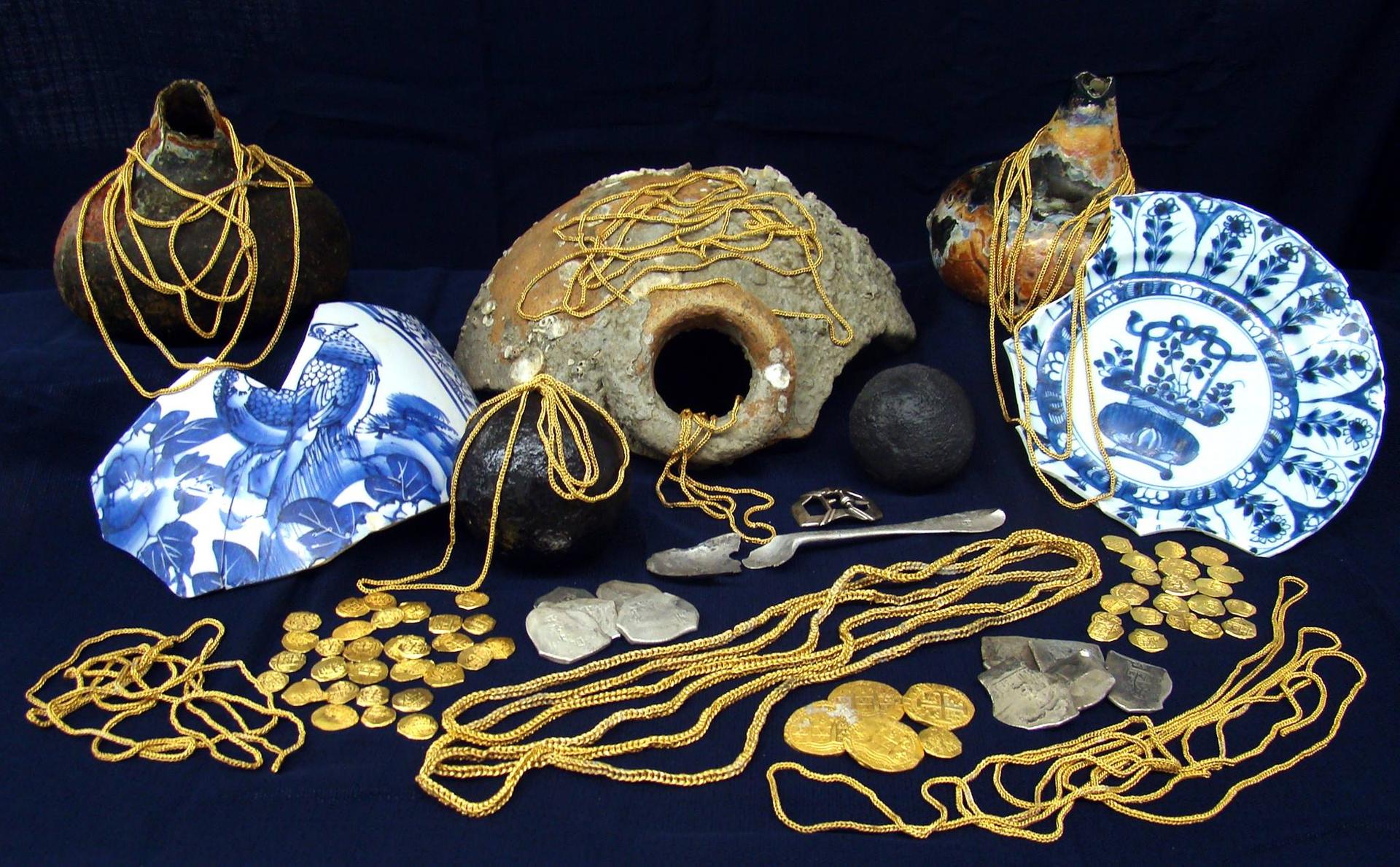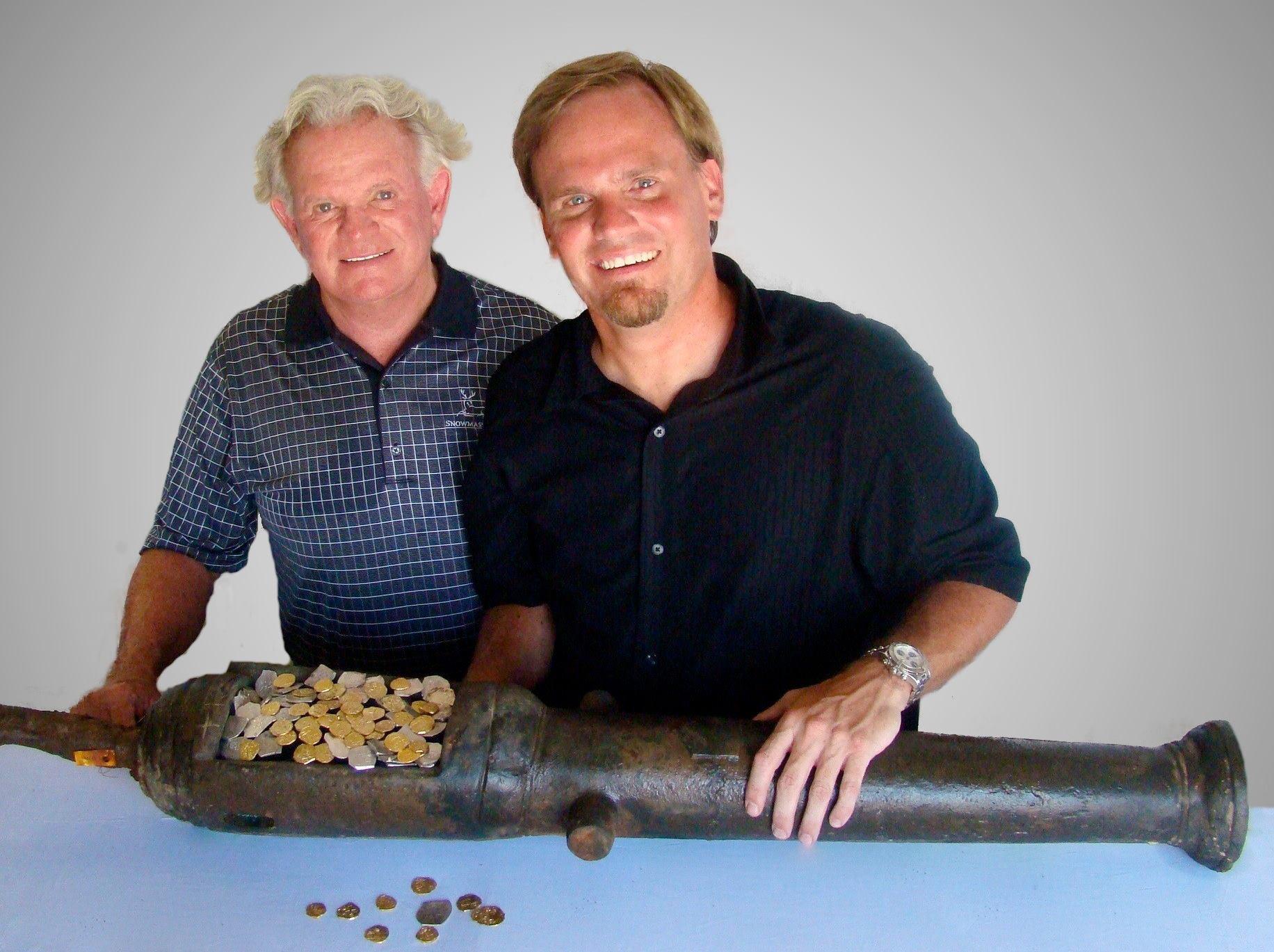For many the term “treasure hunter” may conjure mental images of a dashing hero avoiding ancient traps, or a pirate digging on a sandy beach. In reality, modern-day treasure hunters are willing to put in time, money, and patience in order to strike it big. From Spanish doubloons to Confederate gold bars, there is treasure spread across the world for those with the dedication to find it. Hunters like Brent Brisben and Dennis Parada have incredible stories of discovery, intrigue, and reward.
◊
Even with his headlamp beaming, Brent Brisben could barely see in front of him. The water off Florida’s Vero Beach was cloudy with sediment, white flecks drifting in three dimensions, carried by small eddies through the otherworldly coral shelves. His metal detector had been silent as he patiently swept the rocks and sand beneath him, the bubbling of his released breath mixing with the hiss from his oxygen tanks to fill his ears. Suddenly a chirp came from the machine, breaking the tranquility of swimming through the warm shallows. He almost didn’t believe it at first, but reaching down with gloved fingertips he pulled out something small, light glinting off of it unmistakably. A gold coin.
The coin Brisben discovered had a long history behind it. In 1715, after the War of Succession, newly crowned King Phillip V was in dire need of funds for his recovering kingdom. Fortunately for him there was a backlog of unshipped gold, silver, jewels, and porcelain – at the time valued at 15 million pieces of eight, and worth around $400 million today – waiting in the New World.

Artifacts recovered by Queens Jewels during the 2013 season (Credit: 1715 Fleet - Queens Jewels, LLC, via Facebook)
However, the treasure would never arrive. The fleet of 11 Spanish galleons carrying the valuables was destroyed by a hurricane off the east coast of Florida, and roughly a thousand crew and the entirety of the treasure were lost. The Spanish crown’s initial salvage operations recovered approximately 5 million pieces of eight, but the remainder lay hidden in the reefs and among the wrecks.
Having been long abandoned by the Spanish government, and long forgotten by most everyone else, the rights to salvage the site were acquired in the 1980s from the Florida government by treasure hunting legend Mel Fisher. This agreement came with the condition that he give 20 percent of found artifacts to the state, whose portion would largely end up in museums and aquariums.
Striking It Big On Florida’s Treasure Coast
In 2010, Fisher’s estate sold the salvage rights to the 1715 wrecks to Brent Brisben, the head of his own salvage company, Queens Jewels LLC. Over the next ten years, Brisben and his crews unearthed several notable caches from the area off the Florida coast.
The first discovery came only 17 days after Brisben’s purchase, when his ship unearthed a bronze swivel cannon from a wreck. While this find would be exciting enough in its own right, as the only gun of its type to be recovered thus far, what was more exciting was the collection of coins stuffed in the barrel, nearly 100 of them. This first find was worth nearly $900,000, and the thrill of discovery coupled with the financial reward was enough to enchant Brisben.

Brisben (right) and his father holding the recovered swivel cannon (Credit: 1715 Fleet - Queens Jewels, LLC, via Facebook)
Three years later, in 2013, Brisben and his crews recovered gold coins with a combined value of nearly $700,000 on two separate expeditions within only a five-day period that summer.
By 2015, the value of remaining treasure of the 1715 fleet was estimated at about $250 million, spread along the aptly named “Treasure Coast” of Florida. This area encompasses the counties of Martin, St. Lucie, and Indian River.
In July of 2015, while subcontracting under Queens Jewels, Eric Schmitt and the crew of his boat the Aarrr Booty had been sweeping the area all summer when they hit it big. Over the next few days, they unearthed $1 million worth of gold coins and chains from beneath Florida’s sandy seafloor. (For subcontractors like Schmitt, finds are split between the crew responsible for the discovery and Brisben’s company, after Florida takes its portion.) Little did any of them know, the best was yet to come.
Just a month later, in August 2015, another pair of Queens Jewels subcontractors, William Bartlett and Jonah Martinez, were trawling the area when they came across a find that would make headlines worldwide: $4.5 million in the form of 350 Spanish doubloons. For a man like Brisben, who has worked most of his life chasing the bounty contained in these waters, it was practically a religious experience.
Awed by its magnitude and significance, Brisben said of the discovery “I truly now believe that there is an energy that pervades these shipwrecks, that I can’t quantify. I truly believe that these shipwrecks wanted their story to continue . . . because this story still needs to be told and it’s currently unfolding.”
For the men who found the wreck, the find brought gratification for years of searching. Working together, Bartlett handles most of the diving while Martinez captains the boat. The two men pay out of pocket for their expenses and gear, and a summer of exploring can easily cost $50,000 or more for each ship. However, these expenses are no deterrent, as these men are longtime explorers.
Martinez, who started hunting in 1996 as a hobby, estimates his crew has found around $13 million worth of treasure from the 1715 wrecks as of 2020. While this figure is impressive, the reward has transcended dollar amounts, with much of their satisfaction coming from the thrill of the hunt. Martinez doesn’t sell any of the coins he discovers, and he’s donated several to museums. “It’s like a piece of history,” he says.
Since the 2015 haul, Brisben has largely retired from Queens Jewels, but, according to Janet Begley of TCPalm, he misses the action. It’s hard to match that feeling, sweeping through the sand, hovering above the reefs looking for the telltale shine, getting the chance to rediscover a lost story.
Disappearing Civil War Gold
While Brisben’s story highlights the gratification experienced by some, the results of treasure hunting can be heartbreaking, with lots of setbacks and red herrings. For the Parada family, however, this heartbreak came from the most unlikely of places, and with considerable intrigue involved.
The Paradas’ treasure hunting business, Finders Keepers, is a small, homegrown operation, started in 2004. According to Paradas’ website the entire team consists of only five people: Dennis Parada and his son Kem, and three coordinators for the Pennsylvania and Nova Scotia areas, those being the two areas the team has explored thus far. The Paradas started their business to solve a mystery dating back almost a century and a half – and if they could make millions in the process, all the better.
In the summer of 1863, in the midst of the U.S. Civil War, a wagon train was heading through northern Pennsylvania. Accounts of its origins vary. Dennis Parada says it came from Virginia; an agent of the FBI claims it made its way across the country from Sacramento, California. Regardless of its starting point, the cargo was as precious as it was conspicuous: gold bars, worth an estimated $400 million today, all headed to the U.S. Mint in Philadelphia. But the gold never arrived. This vanished shipment would become the source of a lifelong hunt for Dennis Parada, one he shares with his son, and his reason for starting Finders Keepers.

The Finders Keepers team, with founders Dennis (left) and Kem (second from left).
(Image Credit: finderskeepersusa.com)
According to a vague account written by Parada himself on the group’s website, the whole thing started decades ago. “In 1975 I was given a map that show[ed] where the gold was hidden, so we went to the site in Elk Co. Pa. and found nothing and gave up,” he writes. This initial disappointment was not enough to stop Dennis. The map and its possibilities were on his mind until 2004, when he returned to the site, known as Dent’s Run, with Kem and an advanced metal detector. Unearthing artifacts they had missed in previous years, they received conflicting evaluations: The state’s examiners said the artifacts were not old enough, while third parties concluded that some of the found objects could be from the 1860s.
Undaunted by the inconclusive results, the Paradas continued to search the expansive Allegheny woods, making periodic trips with their detectors. In 2018 Dennis and Kem located “a large metal object.” Scans with detectors capable of determining metal types revealed hits for iron and gold, which Dennis theorized to be iron chests filled with gold bars. This galvanized him to search further and ask for help from the most unlikely of sources: the FBI.
Did the FBI Steal Paradas’ Civil War Gold Cache?
The scan data and accompanying story of Civil War gold made their way to the desk of Special Agent Jacob Archer. Archer is a member of the FBI’s Art Crime Team, a unit responsible for addressing “art and cultural property crime cases,” which often means hunting down and recovering stolen artworks and artifacts. The FBI team has recovered “more than 15,000 items, valued at over $800 million.” After the Paradas presented their evidence up to that point and requested help surveying and digging, Archer contacted them.
Archer had his own reasons to be intrigued by the story of the missing gold. He believed the bars may have been stolen by a group called The Knights of the Golden Circle. This secretive group operated throughout the U.S. during the Civil War period. According to Archer, they were responsible for the disappearance of “weapons, coins, and gold and silver bullion,” much of which was stolen from Union Army trains and depots. The stolen goods were buried across America in caches, whose locations were hidden in coded stories and on secret maps. Sounding familiar?
For more on clandestine groups like the Knights of the Golden Circle, check out the MagellanTV series Secret Societies.
After examining the Paradas’ claims, the FBI agreed to hire a contractor to survey the area, this time with more capable equipment than had been used so far. Agent Archer went to a federal judge to seek a search warrant, stating, “I have probable cause to believe that a significant cache of gold is secreted in the underground cave.”

(Credit: Jingming Pan, via Unsplash)
The scans indicated an object weighing almost nine tons, which equates to around 650 gold bullion bars. It seems that the Paradas’ years of hard work were about to pay off, and Dennis would be able to put his decades-long search to rest – with an amazing payout, to boot. The FBI agreed to send a large team of agents, led by Archer, to dig and investigate.
The Paradas’ elation at finally receiving some validation rapidly turned into frustration, as they were confined to a car for the duration of the search. Around 50 agents swarmed the area, bringing trucks and digging equipment, working through the night. After the better part of two days, the Paradas were led to a clearing to see the fruits of the FBI’s search: nothing. A large pit in the dirt, empty.
To this day, the FBI publicly denies finding anything, despite the recent unsealing of an affidavit from Agent Archer containing 30 pages of evidence pointing to the gold being exactly where Dennis Parada said it would be. The Paradas maintain they were robbed of the find and continue to pursue legal action. For Dennis, the story is not only one of financial loss, but a lifelong search coming to a disappointing end. Years spent going back and forth to those Pennsylvania woods digging through dirt and leaves, all the while believing in that decrepit map, only to have the find of a lifetime (allegedly) whisked away in the dead of night.
Regardless of the outcome, treasure hunters like Brisben and the Paradas continue their quests – further testament to the passion that comes with these hunts, the appreciation for history and the stories it tells through fragments left behind. For most of us, the treasures are a headline – a dollar amount, a get-rich-quick tale. But for people like them, treasure hunting is their life’s work, an endeavor that can be pursued endlessly. For these treasure hunters, the work is its own reward, the treasure just a bonus.
Ω
Title Image credit: Andrew Neel, via Unsplash

